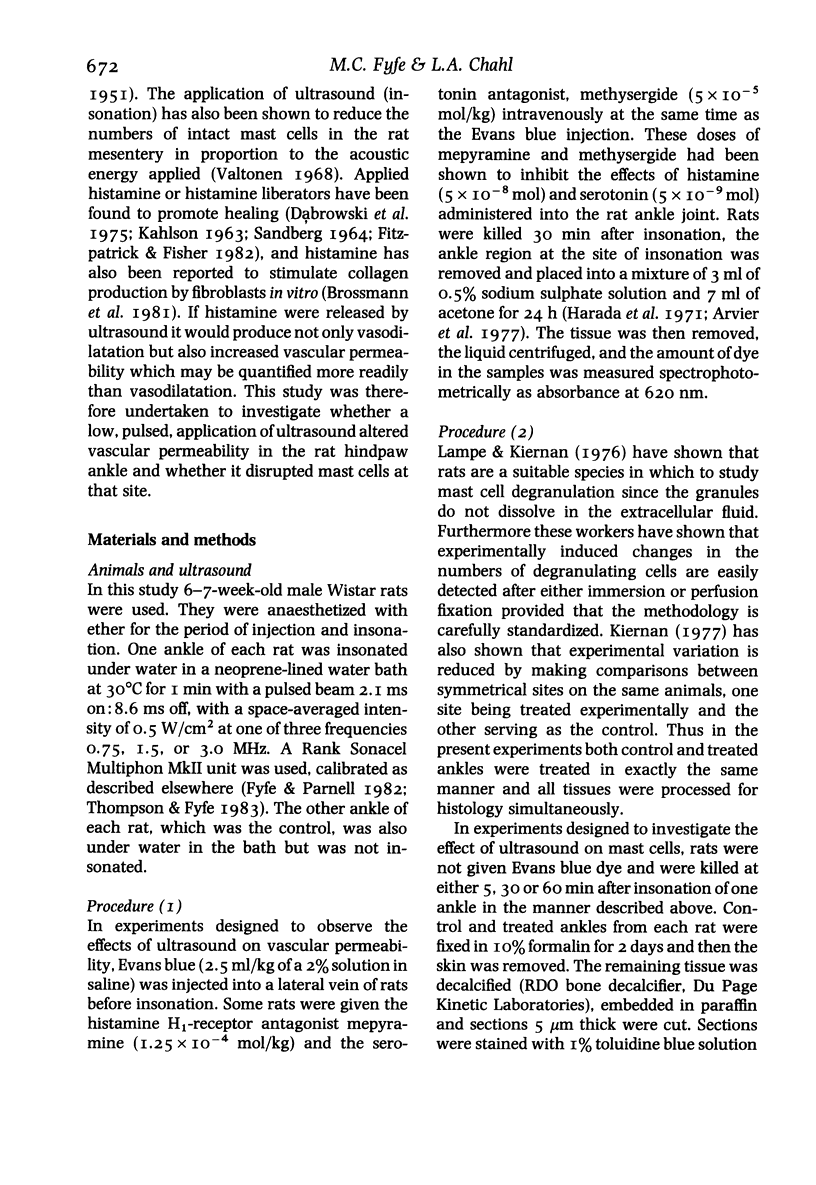Abstract
Ultrasound at frequencies between 0.75 and 3.0 MHz is widely used in the treatment of musculoskeletal injuries in human and veterinary patients. The mechanisms by which ultrasound affects clinical recovery are, however, incompletely understood. At present no clear rationale has been evolved to guide the selection and use of all the factors comprising the dosage of ultrasound in treatment designed to encourage tissue healing. In the present study applications of ultrasound considered to be therapeutic caused a small but significant increase in vascular permeability in the hindpaw ankles of rats in vivo which was abolished by pre-treatment of the rats with a combination of a histamine H1-receptor antagonist and a serotonin antagonist. Histological sections from rat ankles showed that ultrasound also caused a significant increase in the number of degranulated mast cells above control values. Since mast cells contain histamine, low concentrations of which have been associated with healing, the finding that ultrasound produces mast cell degranulation and evidence of histamine release provides a new direction for investigation of the mechanism of its therapeutic action, and for determination of appropriate regimens of treatment.
Full text
PDF





Selected References
These references are in PubMed. This may not be the complete list of references from this article.
- Arvier P. T., Chahl L. A., Ladd R. J. Modification by capsaicin and compound 48/80 of dye leakage induced by irritants in the rat. Br J Pharmacol. 1977 Jan;59(1):61–68. doi: 10.1111/j.1476-5381.1977.tb06977.x. [DOI] [PMC free article] [PubMed] [Google Scholar]
- D'AGOSTINO A., RISI M. Primi risultati dell'ultrasuonoterapia nella cura della malattia di Buerger nell'Ospedale San Camillo in Roma. Minerva Med. 1951 Oct 27;42(72):654–657. [PubMed] [Google Scholar]
- Drastichová V., Samohýl J., Slavetínská A. Strengthening of sutured skin wound with ultrasound in experiments on animals. Acta Chir Plast. 1973;15(2):114–119. [PubMed] [Google Scholar]
- Dyson M., Franks C., Suckling J. Stimulation of healing of varicose ulcers by ultrasound. Ultrasonics. 1976 Sep;14(5):232–236. doi: 10.1016/0041-624x(76)90024-x. [DOI] [PubMed] [Google Scholar]
- Fitzpatrick D. W., Fisher H. Histamine synthesis, imidazole dipeptides, and wound healing. Surgery. 1982 Apr;91(4):430–434. [PubMed] [Google Scholar]
- KAHLSON G. New approaches to the physiology of histamine. Perspect Biol Med. 1962;5:179–197. doi: 10.1353/pbm.1962.0027. [DOI] [PubMed] [Google Scholar]
- Lampe M., Kiernan J. A. Degranulation of dermal mast cells: effects of fixation and of antidromic nervous impulses on two histochemically identified cell-types. Arch Dermatol Res. 1976 Dec 15;257(2):125–129. doi: 10.1007/BF00558085. [DOI] [PubMed] [Google Scholar]
- Morcos M. B., Aswad A. Histological studies of the effects of ultrasonic therapy on surgically split flexor tendons. Equine Vet J. 1978 Oct;10(4):267–268. doi: 10.1111/j.2042-3306.1978.tb02279.x. [DOI] [PubMed] [Google Scholar]
- Niinikoski J. Cellular and nutritional interactions in healing wounds. Med Biol. 1980 Dec;58(6):303–309. [PubMed] [Google Scholar]
- Pospisilová J. Effect of ultrasound on collagen synthesis and deposition in experimental granuloma tissue. Possibilities of clinical uses of ultrasound in healing disorders. Acta Chir Plast. 1976;18(4):176–183. [PubMed] [Google Scholar]
- SANDBERG N. ENHANCED RATE OF HEALING IN RATS WITH AN INCREASED RATE OF HISTAMINE FORMATION. Acta Chir Scand. 1964 Jan-Feb;127:9–21. [PubMed] [Google Scholar]
- Shamberger R. C., Talbot T. L., Tipton H. W., Thibault L. E., Brennan M. F. The effect of ultrasonics and thermal treatment on wounds. Plast Reconstr Surg. 1981 Dec;68(6):860–870. doi: 10.1097/00006534-198112000-00003. [DOI] [PubMed] [Google Scholar]
- Valtonen E. J. A histological method for measuring the influence of ultrasonic energy on living tissue under experimental conditions. Acta Rheumatol Scand. 1968;14(1):35–42. doi: 10.3109/rhe1.1968.14.issue-1-4.04. [DOI] [PubMed] [Google Scholar]


